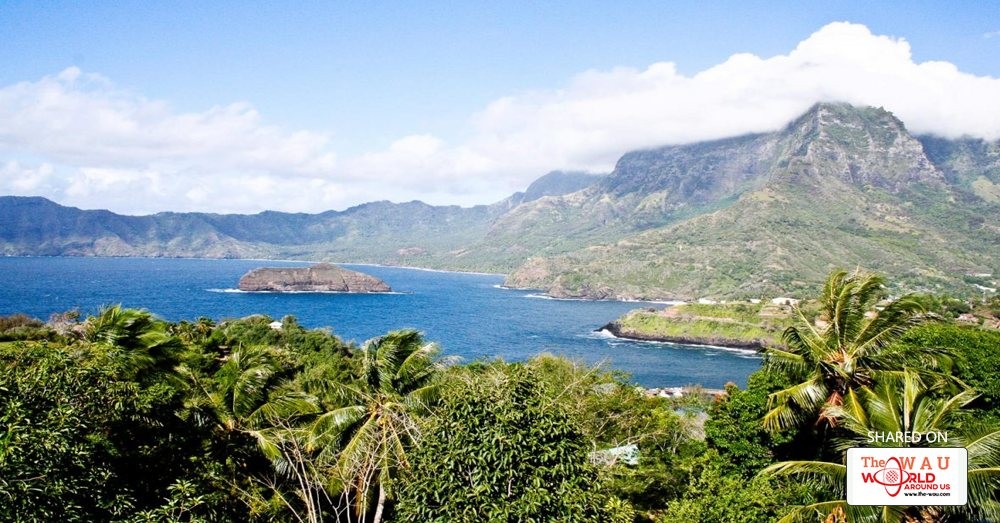In the middle of the Pacific Ocean, the Marquesas Islands float like fragments from a lost world. This is not a resort paradise, it is a primitive place where every castaway and artist would like to get lost.
Here, everything is far away: cities, crowds and even neighbours. There are 5,000km of water between here and the closest continent, America, and the nearest neighbouring island, Tahiti, is more than 1,500 km away. Around the 15 islands that form the Marquesas archipelago—six of which are inhabited—there is nothing but water hiding deep chasms and submarine volcanoes. In fact, the islands are formed by the ridge of a large volcano.

Like in the rest of Polynesia, tattoos are part of traditional culture.
French painter Paul Gauguin lived and died on these islands, seeking to flee civilisation and create more primitive artworks. Another resident, singer-songwriter Jacques Brel, used to sing his famous song Ne me quitte pas (Don’t leave me) while flying his plane through starry nights over the Pacific Ocean. To get there, you have to fly to Tahiti, the big sister of the islands that comprise French Polynesia, and perhaps the best known. The Marquesas are also a member of this French overseas collective, although their traditions are different. From Tahiti, flights go to Nuku Hiva and Hiva Oa Islands, or if time isn’t an issue, catch the cargo ship used on the Aranui cruise, which takes 14 days to land in what many visitors consider the end of the world.

The grave of painter Paul Gauguin in Calvaire de Atuona cemetery is decorated with a reproduction of one of his sculptures.
The archipelago was also a surprise for early explorers. En route to the Philippines, in the middle of nowhere, Spanish vessel San Lesmes came across the mountainous, precipitous islands before sinking in a storm. For 70 years, it was believed the crew had been hallucinating, until, in 1595, Spanish sailor Alvaro de Mendaña found them again and named them Marquesas de Mendoza, in honour of the viceroy of Peru, the Marquis of Cañete.

Nuku Hiva, the largest of the Marquesas Islands, has steep mountains created by volcanic eruptions.
The current population, of Polynesian origin and French influence, is no more than 10,000 inhabitants. The most populous city is Taiohae, capital of Nuku Hiva island, but it has just 2,000 inhabitants. Given its abrupt geography, which abounds with cliffs, dense forests and endless waterfalls, among them Hakui, the third highest in the world, it has become a paradise for ecotourism. You can also visit heavenly corners like the bays of Hanahevane and Hanamenino, on the island of Tahuata, with golden beaches and emerald waters where you can go scuba diving.
The hidden valley of Taipi fascinated Jack London and Herman Melville, two 19th-century adventure and travel writers, who became entranced by the Marquesas, as well as Robert Louis Stevenson. Hiking routes and horse riding excursions go to archaeological sites like Lipona, on Nuku Hiva, one of the best-preserved in French Polynesia, or Hikokua, on the island of Hiva. Both have stone giants known as tiki, which are smaller than the moais of Easter Island and have engravings and different positions. This may prove the theory that the inhabitants of Hiva were the famous rapanui, the first to inhabit Easter Island.
The indigenous people of the Marquesas proudly show off their skin, tattooed with tribal shapes, now mimicked on the streets of New York and London. The craft-based culture creates experts in stone and wood carving. The gastronomy of the islands is based on casseroles and roasts, using freshly-caught shellfish. On Ua Huka island, you can observe islanders busy working to the sound of pahu drums.
This world, scarcely touched by human hand, is where Scottish writer Robert Luis Stevenson ran aground, before writing ‘In the South Seas’. The images and sensations of that journey, which he collected in his book, summarise the feeling of those visiting the Marquesas Islands for the first time: “The first experience can never be repeated. The first love, the first sunrise, the first South Sea island, are memories apart, and touched a virginity of sense.”
Share This Post















